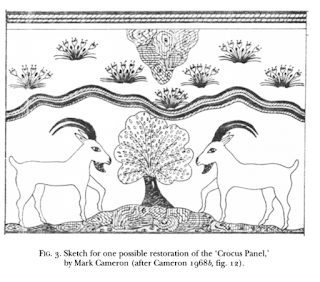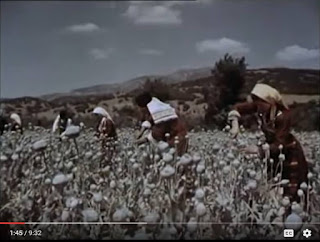This is a beautiful Menat, a sacred necklace/instrument of the Goddess Hathor, the Deified Nile flood.
It depicts goddess Tefnut and god Shu. You can read more about this amazing artefact and its meaning in my post "Menat".
Tefnut (literally "That Water") was the deity of moisture in Ancient Egypt. She is the twin sister and wife of the air god Shu...What do you get when you marry rain and air? Monsoon which feeds the Nile flood.
In the earlier Pyramid Texts she is said to produce pure waters from her vagina...So when one day, she got pissed off :) with Egyptians for taking the piss :) and not giving her enough kudos, she stopped producing pure waters from her vagina, and pissed off :) to Nubia...
There, Tefnut, in a form of an angry lioness, became the terror of the land, attacking both men and animals. She blew smoke and fire from her nostrils and eyes and fed on the flesh and blood of her victims...
Leo, the end of summer, beginning of autumn, the time of maximum heat and no rain, would be the time of droughts and death in Egypt, if it weren't for Tefnut, the monsoon moisture which feeds the Nile...It is this moisture that transforms Leo into time of inundation and life...
Sun god Ra, Tefnut's father, missed his daughter and so he sent Shu (Tefnut's husband) and Thoth (god of wisdom) as his emissaries to ask her to return home. Of course he missed her. Because no Tefnut means no Nile. And no Nile means no Egypt. And no Egypt means no Ra...
For some weird reason, Thoth, disguised himself as a baboon (!!!) and went looking for Tefnut.
When he finally found her (which was probably not that hard, he just had to fallow the trail of destruction), he tried to persuade her to go back to Egypt. First he told her that she should go back to Egypt because it was a much more civilised place than the wilds of the Nubian desert...Blah blah blah...Seeing that the mention of civilisation didn't really have much effect on the crazed murderous fire breathing lioness, Thoth then said that Tefnut should go back to Egypt because of her worshipers. They adore her and miss her and would throw huge party in her honour if she returns and would place on her altars the game she was now having to run down and kill for herself...OooooK...Listening...
At that moment Tefnut's husband and twin brother Shu joined in, and he eventually persuaded Tefnut to go (back) to Egypt...Well moisture (Tefnut) can't go anywhere without wind (Shu)...
Tefnut's return trip became a triumphant procession through the Egyptian villages, just like Thoth promised. The goddess, accompanied by Nubian musicians, clowns, and baboons (???) was greeted by people who rejoiced in her presence, and wild drunken festivals were held in her honour...
As Tefnut progressed down the Nile, she lost her ferocity and became kind and gentle again and the heavenly flow returned :)
Self explanatory, right?
Well, all except the baboons. I mean WTF? Why did Thoth dress up like a baboon? And why did baboons follow Tefnut back to Egypt?
Well this monkey business is very important for understanding this story. Forget about Thoth's yapping about civilisation and such crap. That did nothing. It was the baboon costume 🙂 that did it...It was the fact that Thoth was dressed as baboon that made Tefnut return to Egypt...
The baboon Thoth disguised himself as was not just any baboon. It was Hamadryas baboon.
From Ethiopian highlands. The same place where monsoon (Tefnut-moisture + Shu-wind) causes enormous precipitations starting in March, with the full blown monsoon starting from April/May/June, depending on the season and peaking in Jul/Aug...
Which is the source of the great flood, which is the source of life in Egypt...
Guess what? Hamdryas baboon mating habits are really interesting. Hamadryas baboons don't have a breeding season. Instead, they breed year-round with "peak period in May-July"...In the middle of the monsoon season...And at the exact time when the Nile water level starts to rise...

So you could say that Hamadryas baboon "brings forth Tefnut (moisture, rain)". Well actually it's her "husband" Shu (wind) who finally "brings her forth", but it is Thoth (baboon) who "persuades" her to return...
And so the "moisture from the wind" (monsoon rain), pisses :) on the Ethiopian highlands (and on pissed off :) wet baboons).
And from there it flows as Nile to Nubia and then to Egypt. The triumphant return of Tefnut (accompanied by Nubian musicians, clowns, and baboons :))
Now here is something that I just discovered about the baboons in Ancient Egypt: They were often depicted picking sycamore figs...
Some people think that this means that Egyptians trained baboons to pick the figs for them.
Well, these ones don't look like they have any intention of giving any figs to the people. They are too busy eating them...It is the man actually picking the figs...I don't think this is the correct interpretation of these images...
Here is what I think: Sycamore fig was "the tree of life" of the Ancient Egyptians. Here is Goddess Hathor, the Nile flood deified, the source of grain and life, depicted coming out of a sycamore tree bringing bread to people...
Why?
Here's why: "Sycamore has three main harvests: May, June, August/September". So basically, the sacred tree of Hathor, was full of orange-red ripe fruit from May, beginning of monsoon which was the source of the great flood, until September, the end of the great flood...
You can read more about the animal and plant symbolism related to the Nile flood in my article "Holy Cow"...
Did I mention that the peak mating season of the Hamadryas baboons, the ones who "persuade Tefnut, the rain water, to go Egypt", starts in May, the exact time when the sycamore fig harvest starts?
Could the depictions of the baboons in sycamore trees stuffing themselves with figs be symbolic? Like "The baboons are stealing our figs! Rejoice! Tefnut's vagina is back in business! The heavenly flow (the flood) will reach us soon..." Or something like this?
Anyway...It's gonna rain here soon. Gotta go for a walk before it starts...Take care...And don't look up when it's raining. Who knows what you might see :)





























































